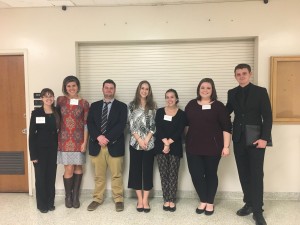By Allison Nelson. Allison is a second year student in the M.A. in History in Bowling Green State University doing research on the history and ethics of post-WWII scientific warfare and policy.
 Usually on an unseasonably warm November day you would find students outdoors, not inside talking about war, slavery, women’s rights, Alcoholics Anonymous, and numerous other heavy subject matters. A little over a week ago, eight BGSU M.A. history students traveled to the University of Toledo on November 18th to present at the annual Phi Alpha Theta History Colloquium. The first set of BGSU presentations were not until 12:30, At 12:30, Dr. Walter Grunden, policy and science historian and associate professor at BGSU, led a panel entitled “Reexamining World War II.” The four presenters were: Kaysie Harrington, first year M.A. student who spoke on the novel and intriguing “The Voices of War: An Analysis of WWII Oral Histories;” Josh Holloway, first year M.A. student, who gave a lively presentation on “American Responses to General George S. Patton Jr.’s Publicity Gaffes, 1943-1945;” Allison Nelson, second year M.A. student, who divulged information on the debate concerning “A Call for Reexamination: A Comparative Historigraphical Analysis of Wernher von Braun and Arthur L. Rudolph;” and, Nichole McCrory, first year M.A. student, who educated the audience on a touching narrative about “Haven or Hell? The Journey to America of Nine Hundred and Eighty-Two European Refugees.”
Usually on an unseasonably warm November day you would find students outdoors, not inside talking about war, slavery, women’s rights, Alcoholics Anonymous, and numerous other heavy subject matters. A little over a week ago, eight BGSU M.A. history students traveled to the University of Toledo on November 18th to present at the annual Phi Alpha Theta History Colloquium. The first set of BGSU presentations were not until 12:30, At 12:30, Dr. Walter Grunden, policy and science historian and associate professor at BGSU, led a panel entitled “Reexamining World War II.” The four presenters were: Kaysie Harrington, first year M.A. student who spoke on the novel and intriguing “The Voices of War: An Analysis of WWII Oral Histories;” Josh Holloway, first year M.A. student, who gave a lively presentation on “American Responses to General George S. Patton Jr.’s Publicity Gaffes, 1943-1945;” Allison Nelson, second year M.A. student, who divulged information on the debate concerning “A Call for Reexamination: A Comparative Historigraphical Analysis of Wernher von Braun and Arthur L. Rudolph;” and, Nichole McCrory, first year M.A. student, who educated the audience on a touching narrative about “Haven or Hell? The Journey to America of Nine Hundred and Eighty-Two European Refugees.”
Although the colloquium was being held in an exceptionally overheated room, a substantial audience turnout was consistent. The next BGSU presenter was Zack Burton, who enlightened his listeners on the topic of “Not Infinite, Not Absolute, Not God: A Historiography of Alcoholics Anonymous and Religion.” The panel that Burton participated in concerned topics surrounding Judeo-Christian Theology and welcomed other interesting and unique presentations by two other academics. BGSU students enjoyed a small break while a panel presented on “Imperial Influence and Ideology.” Then, Nanosh Lucas, a dual History and Spanish M.A. student, presented on “Children in the Atlantic Slave Trade: 23 Vessels Recaptured by the British, 1819-1850.” This panel on “European Perspectives” also heard presentations on medieval European royalty history and the Russian émigré community, 1928-1930. Both Burton’s and Lucas’ talks were received with wonderful inquiries which made for a great discussion for the whole room.
The final panel of the day was made up of only two presenters, Lindsey Bauman, second year M.A. student, and Alyssa Kapelka, first year M.A. student. These panelists created quite a reaction with their captivating topics. Bauman talked about “Suffering in the Voice and Representation of Slaves in 1950s U.S. History Textbooks,” and Kapelka on “Taking Back the Night: Second Wave Feminism and its Effect on Bowling Green State University.” This final panel, as those that preceded it, brought on wonderful questions from the audience. And, each of the questions were met with complete and purposeful answers by the panelists.
There was a plethora of nerves on the day of the colloquium, many of the students feeling the pressure of wanting to bring their best to each of the panels. Others were calm and helped to encourage their fellow colleagues. Two first year M.A. students, Kyle Penzinski and Chris Lause, came out to show their support by attending several of the panels, sitting in the very first row. Dr Grunden stayed well past the WWII panel to encourage other students and offer very appreciated admiration to the BGSU history scholars. Dr. Ruth Herndon, who has had many of these students in her seminars, also came out to carefully listen and demonstrate her consistent efforts in promoting the success of these individuals. Both professors sent out an email verbalizing their positive responses to the colloquium. Dr. Grunden shared that, “as for the presentations I was able to attend, I would have to say that they rank among some of the best graduate presentations I have ever witnessed. There is some real talent among our students, and they represented our program and BGSU as well as anyone could hope.” Dr. Herndon echoed that she was “impressed with the way our students have bridged the first and second year divide that sometimes separates cohorts,” and ultimately the “important take-away is that our grad students did a wonderful and very professional job of presenting.”
BGSU represented the largest cohort at the colloquium, followed by 8 UT students, 2 OSU students, 3 students from Miami University, as well as students representing Michigan State University, Virginia Commonwealth University, and Kent State University. The BGSU students left with a smile on their face, deservingly proud of the work they had done and the chance to share it with others who appreciated their efforts.
